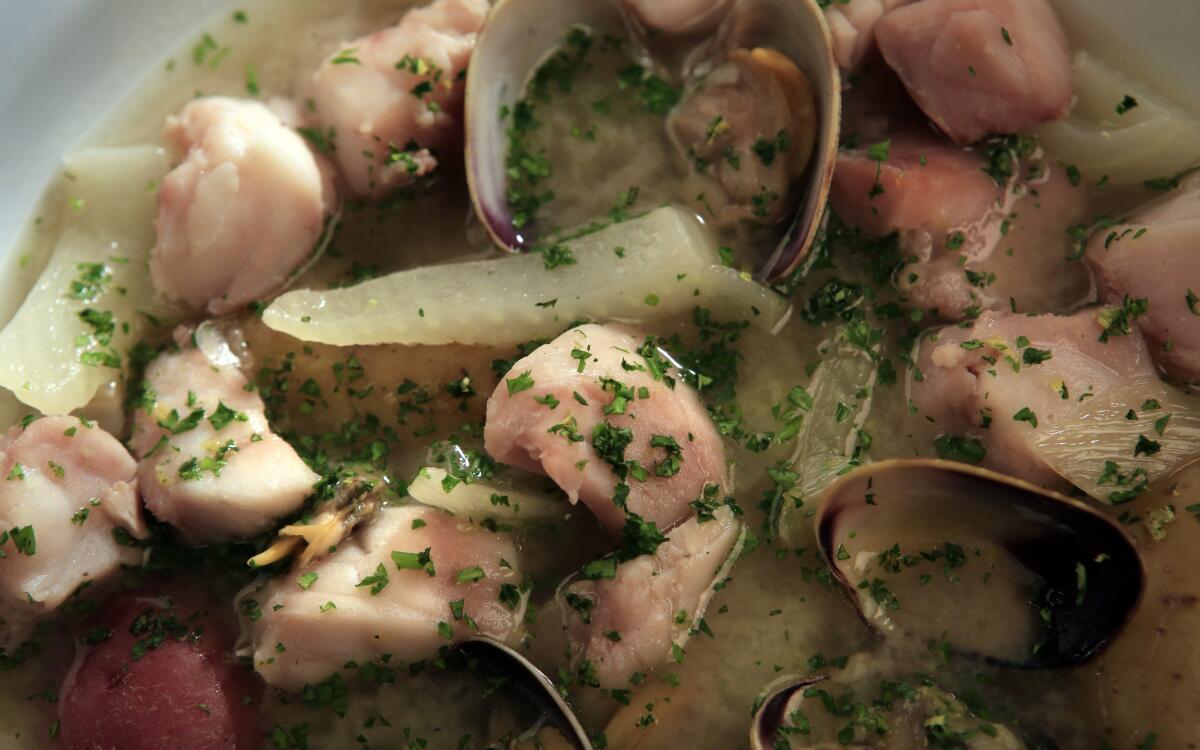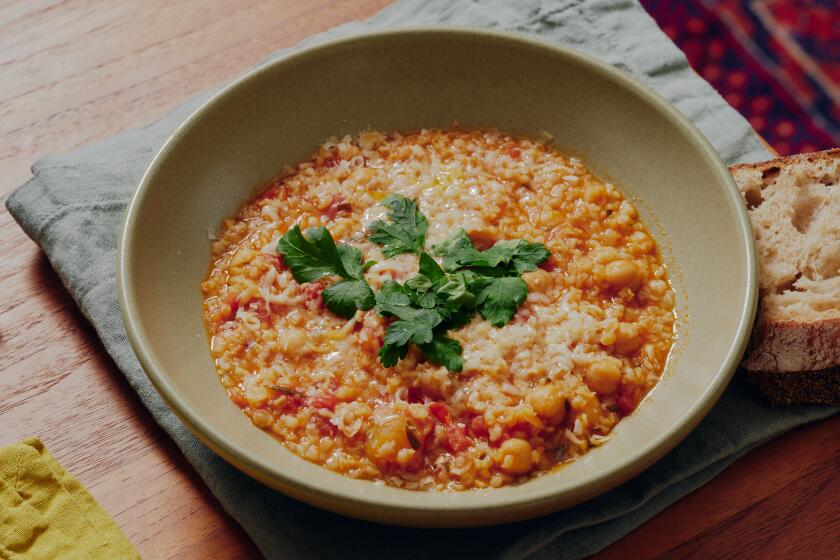Rockfish soup with fennel and potatoes

Now that we’ve saved the fish, can we save the fishermen?
The Pacific rockfish went from near ubiquity to nearly endangered, but today it is a sustainability success story. On top of that, it is everything even the shyest of eaters could want in seafood: It’s a firm, white-fleshed fish with a clean, mild flavor.
But despite all of that, it’s hard to find rockfish at most mainstream markets, and it’s nearly impossible to find it on restaurant menus. And if there’s nobody buying the fish, pretty soon the small, local fishermen who make a living from it will go out of business.
The rockfish’s recent history is enough to give a reasonably attentive observer whiplash.
A large family of related West Coast fish species, for years rockfish was sold mainly under the invented umbrella name Pacific red snapper — a commercially convenient nod to the superlative Gulf of Mexico fish with which it has but a passing resemblance.
Still, that and its amenable character and affordable pricing were enough to make it extremely popular. For years it was one of the iconic fish on the West Coast. So popular did it become, in fact, that the fishery burned itself out. In 2000 it was in collapse, and what once had been a low-cost seafood staple seemed firmly anchored on the Seafood Watch “Avoid” list.
But in a remarkable turnaround, this fall that same much-watched sustainability monitor upgraded most rockfish species to either its top-rated “Best Choice” or “Good Alternative” status.
Ocean watchers credit the rebound in large part to the creation of a wide swath of no-fish zones up and down the California coast, called Marine Protected Areas, as well as other fishery management moves.
But when are we going to start seeing rockfish on our menus?
All this makes Paddy Glennon so angry you can almost hear him sputtering over the phone. “This is one of the most abundant local fish we have in Southern California, and yet it’s one of the most overlooked on menus,” Glennon says.
He’s in a position to know: As vice president of sales at Santa Monica Seafood, one of Glennon’s main jobs is getting fish onto restaurant plates. And he’s passionate about the whole local/sustainable thing.
“You’ve got these chefs who will talk forever about how their vegetables come from 10 miles away, but the fish they serve on top comes from 1,000 miles away,” he says. “I find that complete madness.”
When he talks to chefs, Glennon says, their argument comes down to presentation: The fashion today is for square fillets that fit nicely on a plate, and the rockfish’s roughly triangular fillets throw off the balance.
The best place to buy rockfish today is at Asian markets, such as the 99 Ranch Market and Seafood City chains. There you’ll usually find at least a couple of varieties, and they’ll be sold whole.
That is important because, though fillets are certainly fine, it’s when you cook the whole fish that you get the full beauty of rockfish. Steamed and topped with pea shoots, deep-fried in a cornmeal crust, braised in white wine and tomatoes, or roasted on a bed of potatoes, it is a cook’s plaything.
Maybe best of all is serving it in a soup.
Make a quick stock from the bones and heads (cook it no longer than 45 minutes or so, or you’ll start to pull calcium from the bones, making the broth bitter).
Sweat complementary vegetables in a soup pot and strain the stock over. Bring it to a simmer, add the fillets cut into bite-sized pieces and remove the pan from the heat. Within five minutes the fish will be cooked perfectly, moist and firm.
Because the fish is mild, choose the accompaniments carefully to avoid overpowering it. For a pop of flavor, finish with a sprinkling of fresh herbs — tarragon, chives, basil, cilantro or even plain old parsley.
It may be a little more involved than broiling a piece of salmon, but rockfish is worth the trouble. Being a sustainability success story is all well and good. But being the star of a delicious fish soup is really something special.
Fillet the rockfish, reserving the heads and bones. Cut the fillets into 1-inch pieces, salt lightly, cover with plastic wrap and refrigerate. Place the heads and bones in a large pot and add the wine and water. Bring to a simmer and cook for 10 minutes, skimming any impurities.
Trim the stalks from the fennel, reserving the trimmings, and divide the bulb into lengthwise quarters. Cut the core from the center of each quarter, then slice the fennel into ½-inch-thick crosswise slices.
Add the fennel trimmings, carrot, leek, garlic, bay leaf, fennel seeds, peppercorns, thyme, parsley and lemon slice to the pot, pressing them in with the bones but being careful not to stir, and simmer until the broth is flavorful, 35 to 45 minutes.
Pour the fish broth through a fine mesh strainer lined with cheesecloth into a bowl set over a second bowl of ice. Season with 1 teaspoon salt and whisk to cool. You should have about 4 cups of broth.
Steam the potatoes until tender, about 15 minutes. Cool, and cut each potato in half lengthwise. (The dish can be prepared up to this point a day in advance and the strained broth and potatoes refrigerated tightly covered.)
Heat the butter in a soup pot over low heat, add the chopped fennel and cook, covered, until tender, about 15 minutes. Pour the strained broth over the fennel and bring to a simmer over high heat. Add the clams and potatoes, cover, and cook until the clams open, 3 to 4 minutes. Remove the pot from the heat and add the fish pieces, pushing them gently to submerge them in the hot broth, and cover.
Set aside until the fish is cooked through, about 5 minutes. Taste the broth and add more salt if necessary. Chop together the tarragon, parsley and lemon zest.
Use a slotted spoon to transfer the fish and vegetables to heated soup plates, then ladle over some of the broth. Sprinkle with the tarragon, parsley and lemon zest mixture, and serve immediately.
Get our Cooking newsletter.
Your roundup of inspiring recipes and kitchen tricks.
You may occasionally receive promotional content from the Los Angeles Times.
















